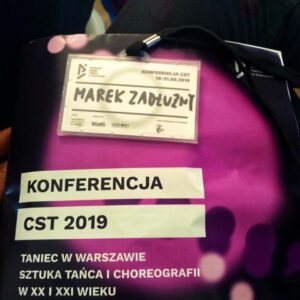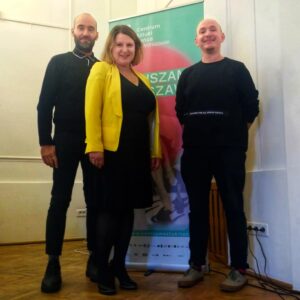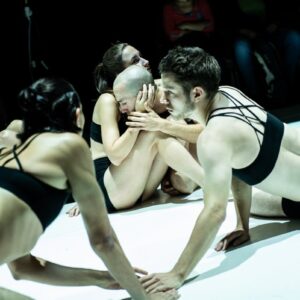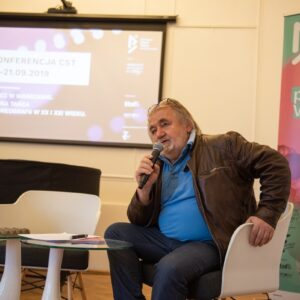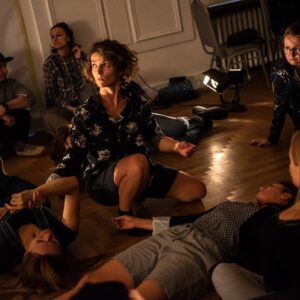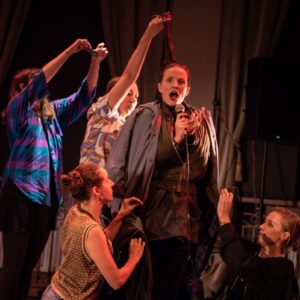CST Conference 2019 - lectures, workshops, performances, meetings
dr Marek Debłużny
Department of Culture Animation and Andragogy
Institute of Pedagogy
Faculty of Pedagogy, Psychology and Sociology
University of Zielona Góra
Publishing review of the book, edited by Marta Seredyńska,
"Taniec w Warszawie. The art of dance and choreography in the twentieth and twenty-first centuries "
Post-conference Publishing House Dance Arts Center in Warsaw
Publishers: PERFORM Artistic Foundation," NOWA FALA "Theater Development Foundation
The publication submitted for review is the result of the National Conference organized by the Center for Dance Art in Warsaw entitled Dance in Warsaw. The art of dance and choreography in the twentieth and twenty-first centuries ", which took place at the Mazowieckie Institute of Culture on September 19-21, 2019. The book, under the same title, is a multi-layered, cognitively interesting study on theoreticians and practitioners' reflections on the art of dance in Warsaw in the 20th and 21st centuries. The editorial procedure used, theory versus practice, colliding seemingly separate worlds, is an undoubted advantage of this volume. From seventeen complementary texts, a heterogeneous picture of Warsaw dance from the turn of the century and the present situation emerges. On the one hand, the book presents the views of young researchers, expanding the field of scientific reflection on dance,on the other hand, the publishing house includes autoethnographic popularizing essays describing the activities of contemporary artists, as well as historiographies of artists who significantly influenced the development of the dance reality in Warsaw in retrospective and presentation terms. The authors come from a variety of scientific backgrounds and orientations, which only strengthens theoretical and conceptual polyphony. The purposefulness of the selection of texts and the well-thought-out and justified composition of the volume draw attention.which only strengthens the theoretical and conceptual polyphony. The purposefulness of the selection of texts and the well-thought-out and justified composition of the volume draw attention.which only strengthens the theoretical and conceptual polyphony. The purposefulness of the selection of texts and the well-thought-out and justified composition of the volume draw attention.
The editor of the volume, Marta Seredyńska, in her introductory text, makes a substantive implication in the current and direction of considerations to which the publication is dedicated. It indicates the legitimacy of the interest in the problem areas discussed and synthetically explains the adopted theoretical and cognitive perspective, according to which the book was composed. The monograph consists of four leading thematic parts. The first chapter is oriented to the social context and concerns the dance life in Warsaw in the first half of the 20th century. The second part in a popularizing retrospective presents historiographies of artists who have significantly influenced the development of Warsaw dance. The third chapter is devoted to the personalities of the turn of the century. We find in it primarily autoethnographic essays,relating to the artistic activity of contemporary artists. The book ends with a part on contemporary inspirations. It contains three texts that complement the whole research with new perspectives and inspiration for further considerations, both in theoretical and practical dimensions. The reader may also find the summaries of the discussion panels at the end of each chapter interesting. They are a necessary complement to the published texts and additionally constitute a commentary that allows to better understand and strengthen their meaning in various social and cultural contexts. Critical voices attract attention, which only proves the correct selection of panelists arousing discussion and the audience willing to talk.It contains three texts that complement the whole research with new perspectives and inspiration for further considerations, both in theoretical and practical dimensions. The Reader may also find the summaries of the panel discussions at the end of each chapter interesting. They are a necessary complement to the published texts and additionally constitute a commentary that allows to better understand and strengthen their meaning in various social and cultural contexts. Critical voices attract attention, which only proves the correct selection of panelists arousing discussion and the audience willing to talk.It contains three texts that complement the whole research with new perspectives and inspiration for further considerations, both in theoretical and practical dimensions. The Reader may also find the summaries of the panel discussions at the end of each chapter. They are a necessary complement to the published texts and additionally constitute a commentary that allows to better understand and strengthen their meaning in various social and cultural contexts. Critical voices attract attention, which only proves the correct selection of panelists arousing discussion and the audience willing to talk.The Reader may also find the summaries of the panel discussions at the end of each chapter interesting. They are a necessary complement to the published texts and additionally constitute a commentary that allows to better understand and strengthen their meaning in various social and cultural contexts. Critical voices attract attention, which only proves the correct selection of panelists arousing discussion and the audience willing to talk.The reader may also find the summaries of the discussion panels at the end of each chapter interesting. They are a necessary complement to the published texts and additionally constitute a commentary that allows to better understand and strengthen their meaning in various social and cultural contexts. Critical voices attract attention, which only proves the correct selection of the panelists arousing the discussion and the audience willing to talk.which only proves the correct selection of panelists arousing discussion and the audience willing to talk.which only proves the correct selection of panelists arousing discussion and the audience willing to talk.
The monograph opens with four texts devoted to scientific reflection on the dance life in Warsaw in the first half of the 20th century. The authors analyze selected social contexts of dance in the interwar capital. Hanna Raszewska-Kursa has researched the biography of Stefania Dąbrowska. She put forward the thesis that the presence of contemporary dance in Warsaw should be counted from 1909. It was the theoretical reflection on the understanding of contemporary dance that became the starting point for the author to present the figure of Stefania Dąbrowska, in her opinion, the first Polish Duncanist, most likely one of the first dancers-choreographers on the Polish non-ballet scene, and thus one of the Polish pioneers of contemporary dance. The article contextually presents the life of Dąbrowska.On the one hand, it shows the gaps in knowledge about its genealogy and private lives, and on the other, it reconstructs the educational path and analyzes artistic activity. The author relies mainly on the analysis of the source materials of the era and, unfortunately, a few studies. Raszewska-Kursa emphasizes in the text that the image presented is incomplete, but calls for Dąbrowska to be considered a symbol of a new era in the art of dance and choreography, and for the artist to be commemorated appropriately. The article draws attention as a scientifically reliable research and historiographic essay. In the next text, Aleksandra Kleinrok describes the socio-cultural changes that took place in the area of dance life in Warsaw before the outbreak of World War II. Asks a question that inspires scientific considerations: "what happened to the salon?".The article deals with the issues of socio-cultural changes in relation to functional dance in the 19th and 20th centuries. Based on the analysis of sources, mainly dance textbooks and selected fleeting materials, the author distinguishes specific problem areas. The topics discussed included: publicization / deprivatization, theatricalisation, militarization and dance savoir vivre. Additionally, the factor of feminization of dance life was also discussed. The theses put forward by Kleinrok inspire reflection on the functioning of the dance culture of the interwar period and may constitute a starting point for further research on social dance of that period. An interesting narrative reflection for the Reader is the article by Grzegorz Kondrasiuk, who in his text describes the phenomenon of a specific fusion between stage dance,acrobatics and circus art in this historical period. According to the author's findings, the interwar eclecticism of circus acrobatics and performance dance as a result of post-war changes (both in circus and contemporary dance) is currently not developed in the reflection of dance theorists. The author proves that at the turn of the 19th and 20th centuries not only contemporary dance was created, but also gymnastics and acrobatics were gaining popularity. These were not fields that developed in isolation. The author shows their mutual influences using artists' autobiographies and press materials. He notices that important dance artists of the first decades of the 20th century: Tacjanna Wysocka, Feliks Parnell, and Loda Halama write about themselves as inventors of a "new" style of dance, minimizing or even ignoring the achievements of others. According to Kondrasiuk, from the mid-1920sIn the 1980s, acrobatic dance not only penetrated into Polish modernist dance, but at the same time it was influenced by the fashion for acrobatics coming from European revue theaters, which was quickly taken over by theaters, theaters and entertainment venues in Warsaw. The last text in this chapter, written by Zofia Załęska, concerns the Warsaw swing and its pre-war inspirations. In the first part, the author synthetically presents the history of dance and the cultural background of its presence in Warsaw in the interwar period. After defining the word swing, the author presented a short history of dance and its transmission to Poland. The second issue raised in the text is the Warsaw swing community and its attitude to the history of dance in the interwar period and during World War II. The author conducted a qualitative survey,which was attended by one hundred and two people learning and dancing swing in Warsaw. The article is an interesting description of the socio-cultural phenomenon of swing dance and its historical connotations. Particular attention is drawn to an attempt to qualitatively analyze the problem area from the perspective of swing dancers today.
The second part of the publication takes the reader into a separate, typically historiographic context of deliberations. It is devoted to the descriptions of the activities of outstanding artists, "personalities of the second half of the 20th century" who made their mark on the history of dance with their artistic activities. In the first article, Aleksandra Konarska gives a retrospective of the works of Stefan Niedzialkowski, the creator of the Warsaw mime scene. The author synthetically presents his artistic achievements and describes the path of development that began in Henryk Tomaszewski's Pantomime Theater. She states that during 55 years of activity, Niedziałkowski not only educated future adepts of this art, but also created his own aesthetic style, which, in her opinion, has points of contact with butoh dance. She points out that Warsaw artists associated with butō,Sylwia Hanff and Iwona Wojnicka were, at a certain stage of their careers, actresses of the Stefan Niedzialkowski Mime Studio. He emphasizes that his technique of work is the result of in-depth reflection on the art of pantomime and has little to do with its ludic, comedic version, the comedy dell'arte, in which it has its origin. In the conclusion of the text, the author states that Niedziałkowski definitely developed this art, following the thinking of contemporary reformers, striving for independence and artistic autonomy. In the next text of this part of the monograph, Iwona Wojnicka undertook a description of the dance and choreographic activity of Witold Gruca, one of the most outstanding dancers of the post-war period. The author of the text focused on the presentation of the artist's profile, paying attention mainly to the choreographies he created and the relationship with film art.In her opinion, looking at the figure of Witold Gruca, one cannot think of him only as a dancer or choreographer, working on the ballet stages of Wrocław, Poznań or Warsaw, because he also used his skills in the film field, as evidenced by the large number of productions on which he had opportunity to work. He has choreographed 30 films, including some of them. Summing up her considerations, Wojnicka states that Gruca can be considered one of the most important representatives of the Warsaw dance community of the second half of the 20th century. Currently, his name appears in studies concerning mainly the history of classical dance and is assigned to the Grand Theater in Warsaw. Attention should also be paid to the fact that Gruca was not only the first soloist and choreographer working in this institution, but also a creator,which should be associated with film art. The article by Mikołaj Mikołajczyk entitled "I started from scratch several times - Gerard Wilk on the Warsaw stage". An extremely interesting text presents the figure of a dancer, pointing to the beginnings of his artistic path and his work at the Grand Theater - National Opera. As the author points out, it was there that in the years 1967–70, Wilk danced the most important male roles, included in the then repertoire of the Teatr Wielki, Siegfried in Swan Lake, Albert in Giselle, Paola in Don Quixote, Prince in Cinderella, Romeo in Romeo and Juliet. In his article, Mikołajczyk made an apt reminiscence of the Warsaw period of Wilk's work, paying additional attention to the ballet films in which he took part and his television career. The author put forward a thesis thatthat Gerard Wilk consciously remained a dancer until the end of his life, who was associated primarily with stage creations (and in Poland also with television productions). In conclusion, he writes in the article: “… He was a great soloist and performer of the title roles, but he had no leadership predispositions that could be attributed to choreographers. He will remain remembered as a performer of the roles of Spartacus, Albert, Romeo, as well as a dancer associated with music videos or television ballets. Undoubtedly, he was an important figure in classical dance in the capital in the second half of the 20th century - thanks to both his talent and personality and lifestyle. " The second part of the publication ends with the text by Ewa Kretkowska entitled "Here I am a prima ballerina - a portrait of Maria Krzyszkowska in the light of period reviews", whose presentation at the conference sparked a dynamic discussion.On the one hand, the article is a biographical case study of Maria Krzyszkowska's creative and professional activity in relation to the then published sources and reviews. It is an attempt to examine her career, and above all, selected stage creations from the 1950s and 1960s, its specific historical conditions and features distinguishing it from the era. In the introduction, the author noted that she is aware of the controversy caused by the figure of Maria Krzyszkowska and that the aim of the article is not to evaluate her person. On the other hand, one should take into account the polemic caused by the author's speech at a conference organized by the Center for Dance Arts. In my opinion, the strong opposition of Mrs. Barbara Sier-Janik and Mr. Wacław Gaworczyk from the dance and ballet section of the ZASP against the image presented in the text,cannot be omitted in the review. It's good that it was included in the discussion at the end of the chapter. At the same time, as a person not directly related to the Warsaw dance community, a reviewer who looks at the phenomena under study with an external eye, I cannot afford to take a position on this controversial issue.
The third part of the publication is devoted to "the personalities of the turn of the century", who significantly influenced the contemporary Warsaw dance scene. The first text by Sonia Nieśpiałowska-Owczarek concerns the impresario activity of Paweł Konica, which took place at the Mały Theater in 1994-2004, which at that time functioned as a chamber stage of the National Theater. This unusual cultural institution was established in the basement of the Centrum Department Stores in Warsaw in 1973 under the management of Adam Hanuszkiewicz. In the article, the author synthetically presented the profile of Paweł Konica and the profile of the impresario stage he led, the most important for dance, to which he invited Polish and foreign artists and hosted dance evenings organized by the Warsaw dance community. Nieśpiałowska-Owczarek states,that dance performances were included in the context of his curatorial research on the fringes of the theater, around which he built an audience at the Mały Theater. He writes that "... Paweł Konic showed the theater of sources, works not shown in Warsaw so far, which had an impact on the Warsaw artistic community. He invited performances and stage events performed by foreign artists, such as butoh dance, comic one-act plays (Shigheyama Kyogen Troup from Kyoto), traditional temple dances from the Bali islands (Made Dijmata with a band), Japanese kabuki dance (Kanchi Hanyagi with a band) , Afro-Brazilian candomblé dance (Augusto Omolú with ensemble). There were meetings devoted to these phenomena, as well as meetings with authors, incl. with prof. Leszek Kolankiewicz on the book "Samba z bogami". According to the author, the model of permanent permanent theater,that Konic developed, became a point of reference for many artists, curators and organizers, who then built their own, original visions of dance scenes and how dance could be presented in them. The emotional commitment of the author of the text is noticeable, who in the panel discussion during the conference clearly emphasized the position that there is currently no space for dance not only in Warsaw, but all over Poland, and in some cases, the existing spaces for many reasons (financial, infrastructural, etc.) cease to exist. exist, which is not really building for the dance environment. A turning point in the narrative for the Reader is the autoethnographic text by Anna Piotrowska. The published essay is an autobiographical attempt to look at the path of the author's creative development,taking into account various areas of her work in Warsaw in the years 1995-2013. The artist comes from Słupsk, but it was in Warsaw that she began to fully develop her creative potential as a choreographer and initiator of educational projects and festivals. Initially, she created the "Distance Dance Theater" in Warsaw, later transformed in 2006 into a functioning and successful "mufmi dance theater". The artist also points to the value of solo works and duets that she created with fellow artists. They helped her develop her own choreographic language and aesthetic style, which she continues to develop today. In the text, the author also draws attention to her choreographic activity in drama theaters and to the awards and distinctions received, which in some way strengthened and strengthened her position and artistic activity,currently implemented, however, not in Warsaw, but in Bytom. It can be said that, in a sense, she extrapolated her artistic achievements to the ground of a new space in a geographical sense. In the next text, Anna Godowska and Sławomir Krawczyński, who have been cooperating since 1999, undertook the description of their own creative work from an autoethnographic perspective. The "Bretoncaffe Theater" founded by them operated in 2001–2012 in Warsaw. In the article, they clearly indicate that in their work they refer to the idea of surrealism by combining contemporary dance / movement, acting, text, music and video projections. The artists synthetically presented the achievements of the theater, which include, among others performances created and performed, received prestigious awards and distinctions at festivals in Poland and numerous performances abroad.Worth mentioning is the project "The Feast of Dreams", launched in 2013, which is a continuation of the search for a method of working with dreams and the unconscious in the practice of dance and theater, initiated by artists in 2005 as "The Dance of the Dreaming Body" during their residency at the Center National de la Danse in Paris. Particular attention is paid in the text to an in-depth description of their working method, which from the reviewer's point of view should be at least briefly quoted here "... The method of the authors of the Festival of Dreams is a creative synthesis of techniques inspired by Jung's analytical psychology, the psychology of the Mindell process and various contemplative and meditation techniques, as well as improvisation techniques that the artists developed themselves during many years of research. Work on the performance - both the work of a dancer,as well as a choreographer and a director - it is a specific kind of analytical process, as understood by Jung, and therefore a process aimed at integrating conscious and unconscious content. According to this assumption, each spectacle is a specific examination of a certain aspect of the world from the point of view of sleep, which is the captivating messages of the unconscious ”. The article is an interesting cognitive study that sums up the artistic activity of Anna Godowska and Sławomir Krawczyński in the field of theater and dance. Their own biographical perspective allowed for an in-depth presentation of the original method of creative work, which has its foundations in the concepts of surrealism, psychoanalysis, the unconscious and dreaming. Aleksandra Pacak-Dragańska, on the other hand, attempted to describe the broadly defined work of Edyta Kozak.In the text, the author presents her dance, choreographic and curatorial activities. It presents the artist as a person who effectively performs many functions. As a successful dancer, co-creator of many events in the field of contemporary dance, and at the same time the president of the "Body / Mind Foundation" and the director of the "International Body / Mind Festival". Later in the text, he presents her career path in Poland and abroad. A revolutionary turn in the artist's biography is intriguing, and at some point she decides to depart from classical ballet and redirects her creative research towards contemporary dance. It is worth paying attention to the artist's inspiration with performing arts, experimental forms and the conceptual dance trend, which may be a natural consequence of departing from the rigid framework of the classics.Her popularizing projects promoting the art of dance, including the Polish dance scene, should be particularly emphasized. The author made an extremely difficult condensation of the rich starting material, which she mentioned in the discussion, in order to present to the Readers the most important contexts of the multi-area and culturally significant activity of Edyta Kozak. Another artist who made a narrative flashback of her activity is Elwira Piorun. The author is a graduate of the Warsaw ballet school and is still connected with Warsaw. The first part of the article describes both the beginnings of the artist's dance path, who was a soloist of the Grand Theater - the National Opera in Warsaw, and her achievements after returning home from Germany, where she danced on stages in Hagen and Dortmund. The artist points out thatthat she had the opportunity to watch Pina Baush performances in Germany, which made an impressive impression on her. The work of the Zawirowania Dance Theater, founded by Elwira Piorun and Włodzimierz Kaczkowski, was also summarized in the following part of the text, in which the artist fulfills herself as a dancer and choreographer. In addition, she is an educator in the field of various dance techniques as part of the "Zawirowania Dance Academy" and works effectively to popularize dance in the capital. In the context of these considerations, apart from artistic achievements, the educational activity of Elwira Piorun is particularly noteworthy, as it has a wide impact on young dance students and plays a highly cultural role in the field of contemporary dance. The third part of the monograph, devoted to the personalities of the turn of the century,ends with an autobiographical text by Ilona Trybuna about her artistic activity in Warsaw. The author is a graduate of the General Ballet School of J. Jarzynówny-Sobczak in Gdańsk. In 1989 she started working in the ensemble of the Warsaw Chamber Opera, which she mentions in the text as very satisfying. For two years she also danced in the Musical Metro, which made her realize that the classic is not a sufficient means of expression for her. In 1995, she made a shift in her career towards independent art work. She began searching for a new method of working with the body, and establishing cooperation with musicians from the Polish jazz and avant-garde scene resulted in the development of improvisational art in dance. He states ”… In Poland at that time no one talked about improvisation in dance as a method and technique of work.So I initiated many activities, which I consider valuable and important for the improvisation community in Warsaw and Poland ”. The author has been developing her method of work for over twenty years, successfully dealing with education in this area. He is a lecturer at many centers that deal with academic education in the field of dance and choreography. Trybła is also a co-creator of the "International Dance Improvisation Festival (sic!)", Which functioned in the years 2007-2012. At that time, the world's best experts in dance improvisation came to Warsaw to share their knowledge and experience, which, according to the artist, was a pioneering event on a national scale. The tribunal also ran, together with Maria Stokłosa, the "Improvisation Laboratory", which was a space for education, exchange of ideas and experiences in the field of improvisational dance.The author presented her activity from the subjective perspective of an artist-researcher, which allows her to be treated as an interesting, from a cognitive point of view, autoethnography.
The fourth part of the book deals with contemporary inspirations in the area of the Warsaw dance scene. There are three texts that provoke further reflection and open polemics. Perhaps they will become a contribution to the organization of further thematic conferences, devoted not only to the situation of the Warsaw, but more broadly, the Polish dance community and its social and cultural conditions. This chapter opens with a reliable and competently written article by Julia Hoczyk, who undertook a description of the Warsaw butoh community. The author, as an expert in the subject, easily uses cultural contexts and introduces the reader to the meanders of this particular dance genre. At the beginning, he explains the semantic fields of considerations, and then presents the profiles of the artists and the aesthetics in which they move. He aptly noticesthat for almost two decades, butoh dance in Warsaw has developed in parallel with other forms of this art, such as contemporary or classical dance. Interestingly, the creators of this specific genre have managed to gather around them a community of enthusiasts who not only participate in artistic events, but also actively participate in workshops and various initiatives from the borderline of various fields of art, such as installations, shows, lectures and meetings. In the article, the author synthetically presents the most important activities of artists and butoh animators in Warsaw over the last several years. A large part of the text is devoted to the description of the activities of Sylwia Hanff and her "Limen Butoh Theater". He also remembers Iwona Wojnicka's projects from the time when she was still involved in this area of motor practice.Later in the text, he presents Anita Zdrojewska and the activities of her POMPKA Foundation. The whole argument conducted by the author is completed by the conversation with Anna Juniewicz, who belongs to the young butoh generation. In conclusion, the text discusses the aesthetics of selected performances, and additionally recalled the profiles of foreign artists who visited Poland at the invitation of the above-mentioned butoh promoters (headed by Atsushi Takenouchi and Joan Laage). The next article touches upon an important conceptual category from the perspective of the development of the critical thought of Polish dance. "Solo Generation" was coined and popularized by Anna Królicka, and this semantic construct is also the first part of the title of her 2013 book. In her text, the author this time makes theoretical revisions and asks an opening question:What is Solo Generation Today? An extremely interesting article is an attempt to re-examine the generational concept of the solo generation. The author first skilfully introduces the reader to the essence of the issues and the basis of contextual conditions. He points out that the solo generation began to form along with the initiative of Joanna Leśnierowska, who in 2006 established the "Solo Projekt" implemented in Stary Browar in Poznań. This program was a space of artistic exploration for a large group of young choreographers looking for their place on the art market after returning to Poland, most often from a stay abroad related to professional dance education. The author states that the consistent choices of curators and the interest of researchers and critics led to the formation of a characteristic style of the generation,negating ballet traditions and "Tanztheater", called "new dance" or "new choreography". Królica, 13 years after the establishment of the Poznań residence and six years after the publication of a book with a series of interviews with young choreographers, makes a successful reminiscence in the text. It analyzes the artists' achievements and their current functioning in the world of dance. It also asks what is the new dance today? Summing up, he states that "The Solo generation and their peers are literally acting in front of our eyes, their presence on the art market still generates discussions, although the form of their statements has already become familiar and rather accepted". The book ends with an article by Magdalena Przybysz "Invisible choreographies of Warsaw - about the choreography of everyday life in the city tissue". Reading it, you get the impression that it is a unique text,of a "performative" nature, which the author provokes to a careful perception of the reality around us in the material and non-material sense. In the introduction, he puts forward the thesis that choreography is present everywhere, regardless of whether it is visible or invisible. He further presents his path of artistic development. She describes a meeting with Zorka Wollny, who inspired her to implement projects focused on the issue of invisible choreographies. She remembers Rafał Urbacki and his concept of everyday choreography, which she managed to develop. In her view, these are all sensory and motor experiences that occur in everyday life in a specific time and space. They can be individual (e.g. driving choreography) or collective (e.g. traffic jam).In the text, he presents his original diagram of the "map of contemporary choreography", which accurately systematizes the currently implemented choreographic practices. He also gives examples of invisible choreographies that can be found in Warsaw. In her opinion, these are, among others: "choreography of arrivals and departures at the Chopin Airport in Warsaw, choreography of vegetation, illuminations, people and buildings in the gardens of the Museum of King Jan III's Palace at Wilanów, choreography of the dead bodies of animals and living people at a meat stall. , choreography for the traffic jam in Mordor in Mokotów, choreography seen from a bird's eye view on the dancing black umbrellas in Krakowskie Przedmieście, choreography for the whirling CO2 emission into the atmosphere at the Siekierki Heat and Power Plant, choreography for wrapping the landscape of the Kabacki Forest in smog ".The text ends with the author's socially engaged appeal, who believes that the function of contemporary choreography should be primarily to provoke the society to think critically.
In conclusion, it should be clearly emphasized that the individual chapters of the publication are ideologically consistent and do not raise any objections from the reviewer. The texts are thoroughly prepared and present various areas of socio-cultural, dance reality in the interwar and contemporary Warsaw. The book makes a significant contribution to the development of knowledge about dance and should reach the broadest possible culture-creating environments related not only to artistic dance, but also to dance recognized as a rightful category of social practice.
Marek Debłużny
October 30, 2019
Stay in the capital and participation in the CST conference 2019 Conference - lectures, workshops, performances, meetings
A time full of inspiring meetings, artistic experiences and social lobbies
In the captured frame: the
curator of the scientific part of the conference, mgr Marta Seredyńska and the reviewers of the upcoming monograph on the art of dance and choreography in Warsaw in the 20th and 21st centuries,
dr hab. Wojciech Klimczyk and Dr. Marek Zadłużny

